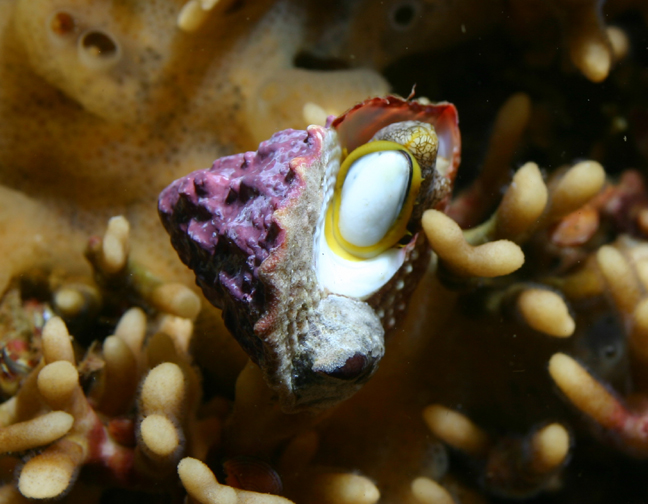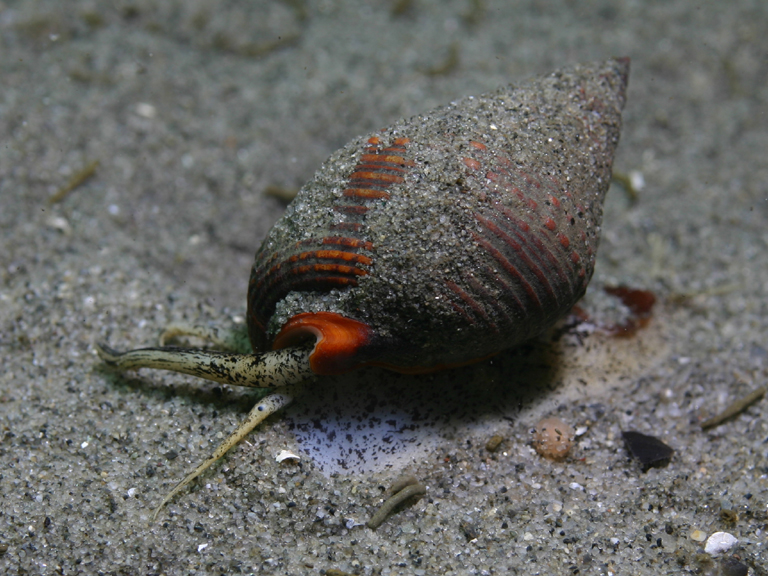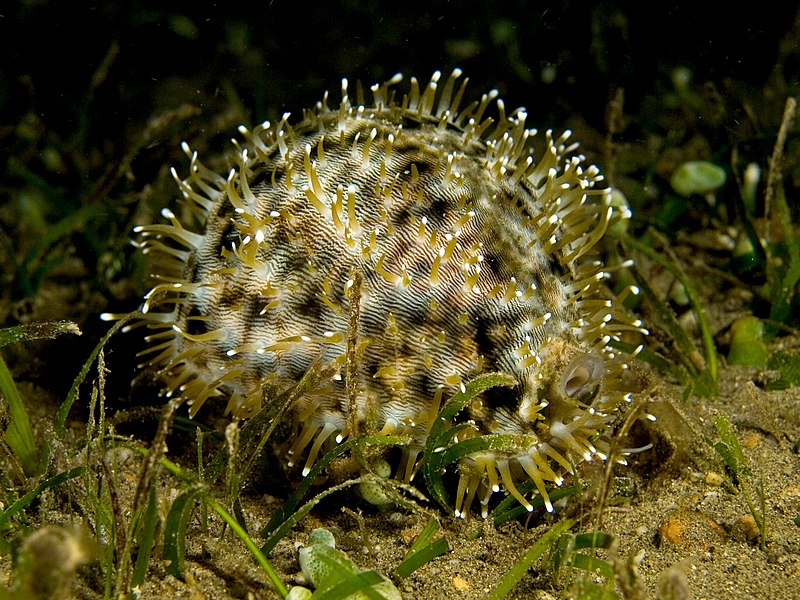 “Why is that snail just sitting there? Is it dead? Why do they keep dying?”
“Why is that snail just sitting there? Is it dead? Why do they keep dying?”
Common questions with a lot of possible answers – Water quality, mineral or vitamin difficiency, starvation, predation – but often the solution can be quite simple…it fell down and couldn’t get up. Snails crawl around all the time, but falling off of a surface and ending up with their shell on the sand can be a death sentence.
Most snails aren’t adapted to environments where there they may get flipped upside-down (like falling off the straight sides of an aquarium). They are from environments where they are either not climbing at all (like sand flats) or where if they do fall, they either roll until they are right-side-up again or fall where they can reach another surface and right themselves. Being upside-down for short periods of time won’t kill the snails, but it does leave them vulnerable to predation from tankmates, and they can’t feed or do any other normal snail things. Some snails can flip themselves over like acrobats, but others may need a hand if they get stuck.
Here are a few common aquarium species. Keep in mind that even those that are able to flip can still get stuck depending on their position and the terrain:
Turbo Snails (Turbo sp.): While some Turbo’s can flip themselves over, most struggle. These snails end up on their backs often since they tend to be glass-climbers and fall off frequently if startled. Their heavy shells cause them to be top-heavy, and if they fall into open sand or substrate it can spell disaster.
Margarita Snails (Margarita sp.): Another one of the common glass-climbers. Some will flip themselves over, but again the substrate or lack of reachable ornamentation can make the task impossible.
Nerite Snails (Nerita sp.): These snails tend to cling to surfaces well and usually don’t end up in a situation where they need to flip very often. If they do fall, they can usually flip themselves over with ease. The bigger problem with these is their habit of climbing completely out of the tank!
Trochus Snails (Trochus sp.): These have pyramid-shaped snails. Trochus Snails (also called Turbo Snails or Turban Snails by some) have the ability to right themselves pretty easily as opposed to some of their nearly identical cousins.
Astrea Snails (Astraea sp.): This is one of those nearly identical cousins. Astrea Snails are notorious for climbing, falling and dying. Always make sure they are right-side-up when you put them in your tank and flip them over if you see them overturned.
 Nassarius Snails (Nassarius sp.): These snails don’t venture out of the substrate often. They usually have no problem flipping as they are quite agile and have a long and nimble foot. These are the break dancers of the snail world – they whip their foot around until they find something to grab onto or the momentum flips them over.
Nassarius Snails (Nassarius sp.): These snails don’t venture out of the substrate often. They usually have no problem flipping as they are quite agile and have a long and nimble foot. These are the break dancers of the snail world – they whip their foot around until they find something to grab onto or the momentum flips them over.
“Conchs” (Strombus sp., Lambis sp. and a few others): This is a very wide group. Their relative safety depends on the species, but most of the true conchs (Strombus sp. and Lambis sp.) are never really found climbing around so don’t usually have this problem. They are usually in or on the substrate. Some conchs have very ornate or heavy shells that can hinder their movement if they get stuck, but most others can usually use their strong foot to their advantage and don’t have too much trouble.
Cerith Snails (Cerithium sp.): There are many different types of cerith; some climb surfaces (and even out of the water like the Nerites) and some stay buried in the substrate. Because of their very cone-like body shape, they don’t often get stuck to where they can’t right themselves, but depending on the terrain, it can happen, especially if you have a lot of rock. Its a good idea to flip them over if you think one may be in trouble.
 Cowries (Cypraea sp.): Cowries are climbers and are very good staying stuck. If they do happen to slip, there isn’t much they can do to help themselves. Their slit-like opening and shell-covering mantle gives them good suction on a flat surface, but not much torque to be able to allow them to flip. Larger, heavier cowries can be especially clumsy; they do need your help.
Cowries (Cypraea sp.): Cowries are climbers and are very good staying stuck. If they do happen to slip, there isn’t much they can do to help themselves. Their slit-like opening and shell-covering mantle gives them good suction on a flat surface, but not much torque to be able to allow them to flip. Larger, heavier cowries can be especially clumsy; they do need your help.
Other climbers – Starfish and Urchins: Customers also share concerns over these reef creatures and their mobility. Some starfish have suction cup-like tubes feet down each leg that they can control like hydraulics; urchins have rows of these tubed feet covering their entire bodies. It may take some time depending on the species, but a fallen starfish or urchin can usually flip themselves with little effort (although some assistance from you wouldn’t go amiss).
These are just a few examples of what the snails are capable of in the ideal aquarium environment. Research any new choices carefully, but when in doubt, just flip them yourself and help your snails survive.
Thanks,
Eileen
Tiger Cowrie Snail image referenced from wikipedia and originally posted by Nhobgood
 That Fish Blog – Aquarium Advice and Information
That Fish Blog – Aquarium Advice and Information

Do u happen to know abt garden snails? (:
Hello Jamie, We don’t really deal with garden snails here but as far as I know, they should be able to right themselves if flipped over.
Thanks eileen (:
I have an apple or mystery snail, and in placing him in the tank after a cleaning he landed on his back and bubbles came out of his shell, i need to know if he will be ok. to clarify he was not dropped but in being placed he turned over.
Hi Elizabeth, Is the operculum (the hard “trapdoor” over the opening) still attached? If you press on it lightly, it should feel firm. If so, there was likely just an air bubble in the shell from the snail withdrawing quickly or being exposed to air. If the operculum is gone or the snail feels mushy when you press on it, it may not have survived.
Hi I have 100 cerith snails all of a sudden and I have a 1 gallon tank. I want to keep the snails for sure but I don’t know how many gallons I’ll needPlease help!
Hi Reese, That is a complicated question. Cerith Snails don’t necessarily have a minimum tank size but you will want to make sure they are getting enough food and the water quality is staying good as the snails grow and feed. A 1-gallon tank is EXTREMELY small for any saltwater animals. If you plan on raising the snails, I would recommend at least a 30-gallon tank to keep the water quality and parameters stable with the amount of food they will need and waste they will produce.
Would u know why my fish are push my snails of the glass and decorations?
Hi Angel, I’m afraid I don’t understand your question. If you could elaborate on what information you are looking for and more information about your tank, I’d be happy to help you out.
Hi! I have two nerite snails and one of them (who’ve I named Barry) keeps getting stuck and I flip him over. I’ve been looking into it and a theory is he could be trying to mate with they other snail, and I guess they chase each other? I’m not a snail expert, but I’ve researched alot about zebra nerite snails and I’m just really confused. Some say they don’t have a gender, that they’re hermaphrodites. While others say they’re male/female. The fish store I got them from said I wouldn’t have to worry about them reproducing because they don’t breed in freshwater, but only it says they can just they eggs won’t hatch.
All in all, is it possible that Barry is getting stuck because he’s trying to get lucky? Or is he just a clutz? They other snail (whose named Sheldon) doesn’t seem to have any issues maneuvering and etc.
Hi Dino Jai, Nerite Snails do have two distinct genders but telling them apart is very difficult and breeding them is almost impossible. If one of your snails is having difficulty maneuvering or is acting strangely, I would test your water parameters to make sure everything is within a healthy range since snails can be sensitive to water quality and dissolved oxygen levels. Even if one is acting normally, another may be more sensitive and water tests are always important and can tell a lot about what is going on. Nerite Snails can usually right themselves but may get stuck, depending on the topography of the aquarium and how they land. I haven’t heard about Nerite Snails “chasing” each other in an aquarium.
Hi I was worried about my mystery snail. He escaped from the tank and cracked his shell. The very front part of the shell came off. However I checked and as far as I can tell the soft body isn’t exposed. It’s been about a week or 2 weeks and a soft gray covering is beginning to form so I believe he’s trying to re-build his shell. However he’s acting very strange. He’s no longer as active as he once was and when he does move it’s mainly just climbing up to the top of the tank then coming down. His operculum also won’t close so I think there’s something wrong. Half of his foot is usually just out and when he flips over on his shell he never flips back so I have to flip him over. I put him near food and he does eat it but overall I’m worried about my snail. I looked things up and some websites say that when a snail goes through this they can perk right up or they may be dying or it may simply be a water issue. I did a 100% water change And conditioned the water. My golden snail is doing just fine. Is there anything I can do to help him? I was thinking about adding cuttlebone to my tank so he could get more calcium but I’m not to sure if that would truly help.
Hi Kennedy, There isn’t much that can be done at this point other than making sure the water quality remains good, especially if you’ve done a complete water change that would restart the cycling process in the tank and you may see spikes in Ammonia and Nitrite. I wouldn’t recommend adding cuttlebone to the tank; that may cause more problems than any benefit the snail may see.
Hi I’m worried about my Assassin Snails. They are laying upside down slightly out of shell, I have pictures. They haven’t moved for days. I’ve got them out and they don’t smell but they don’t retreat either. Ive popped them back in the right way up but find them turned again. Don’t know if it’s the fish nudging them back over
Hi Ellen, If you;d like, you can email your photos to fish@thatpetplace.com and we can take a look for you. Including information about your tank (tank size, other animals in the tank, basic parameters like Ammonia, Nitrite, Nitrate and pH) would also be helpful. If the snails are hanging out of their shells and not retracting or responding at all, that is usually not a good sign.
My mystery snail fell from the top of his 5ank and landed on his shell
I flipped him back over but he hasn’t moved for several hours.
How can I tell if he us ok?
Hello Gillian, Is the operculum (the hard “trapdoor” over the opening) still attached? If you press on it lightly, it should feel firm. If the operculum is gone or the snail feels mushy when you press on it, it may not have survived.
I have a land he came to me in a poinsettia plant with slugs. I found him this morning stuck on his back. I don’t know how long he had been like that. The front part of his shell where his head comes out was completely clear looking. He was curled up all the way in his shell that I thought he dried up. I sprayed some distilled water in his shell thinking this would help lubricate him? He did come out and started moving, however I’m not sure the front of his shell should be clear like that? How long can they be on there back before they dry out? Can they dry out? Was spraying water on him ok? He is a baby maybe only 2 months old. He is very tiny.
Hi Brooke, We deal with aquatic animals here and don’t do much with things like terrestrial plants and snails but generally speaking, younger snails will have thinner shells than older snails. Distilled water isn’t usually recommended in aquatic animals since it is missing beneficial minerals and buffers. If it came out and was moving around afterward, it may be fine.
Hi I just got into snails I have a mystery snail and I can not find him. One time I watched him bury himself so I knew he was ok this time I haven’t seen him in 24 hours, do they bury themselves often? He never did that til I changed him to a larger tank.
Thanks,
Karie
kariegrasseschi81@gmail.com
Hi Karie, That is normal for some snails but can be a sign of stress. Make sure that your water parameters are all good and that there are plenty of hiding places available from bright lights since the snails are naturally more nocturnal.
Small question: my snail (Larry) was OK last night and this morning his shell looks empty and I don’t exactly know where his trapdoor is or any of that stuff. He’s a gold mystery snail, and I got him last week as my first snail. I’ve cleaned the water and tank once while he was alive (if he’s dead now) but he was still alive when i put him back in; I checked, and he suctioned himself onto the glass after half an hour.
My friends think Donnie (my betta and Larry’s tankmate) may have eaten him. Is that possible? They were getting along fine – Donnie was mostly just curious and never acted aggressive or threatening – and now Larry’s shell is empty and he may be dead but I don’t know how to tell or if he is just playing dead.
His shell looks completely empty aside from one stringy thing in it.
I realize I’ve been talking in circles so I’ll stop now. Thanks in advance. Here’s hoping Larry ain’t dead.
Hello denny, I’m afraid I’m a bit confused as to what you are describing. Is the shell empty or is there something in it? The “trapdoor” operculum would be dark brown and inside the opening of the shell if the snail was in it. If the shell is completely empty, the snail is dead and gone. I wouldn’t expect a betta to kill a snail but without knowing more about the tank, I wouldn’t be able to say what may have killed it if it is gone. If there is still something blocking the opening of the shell and it feels firm if you lightly press on it, Larry is probably just fine.